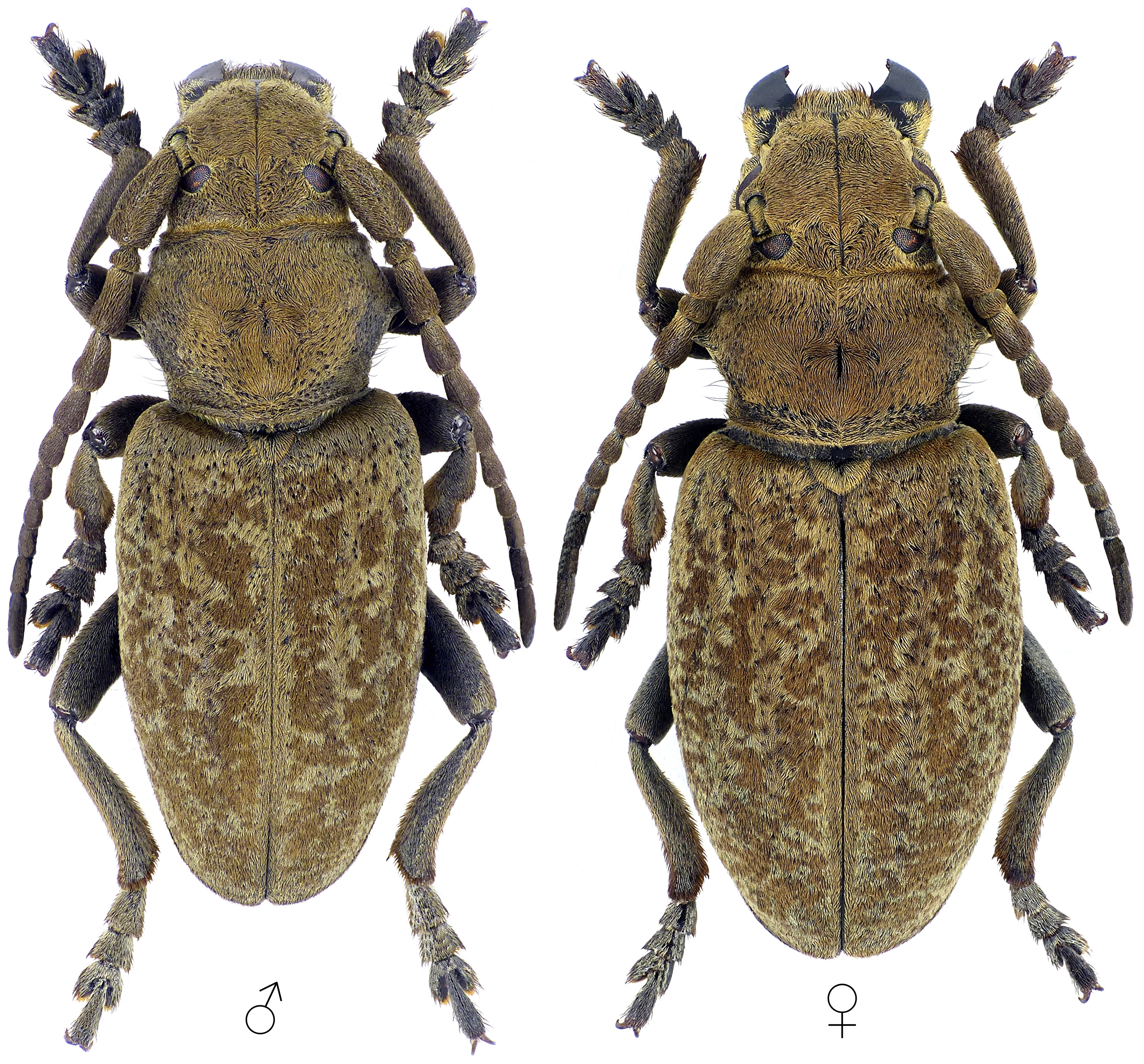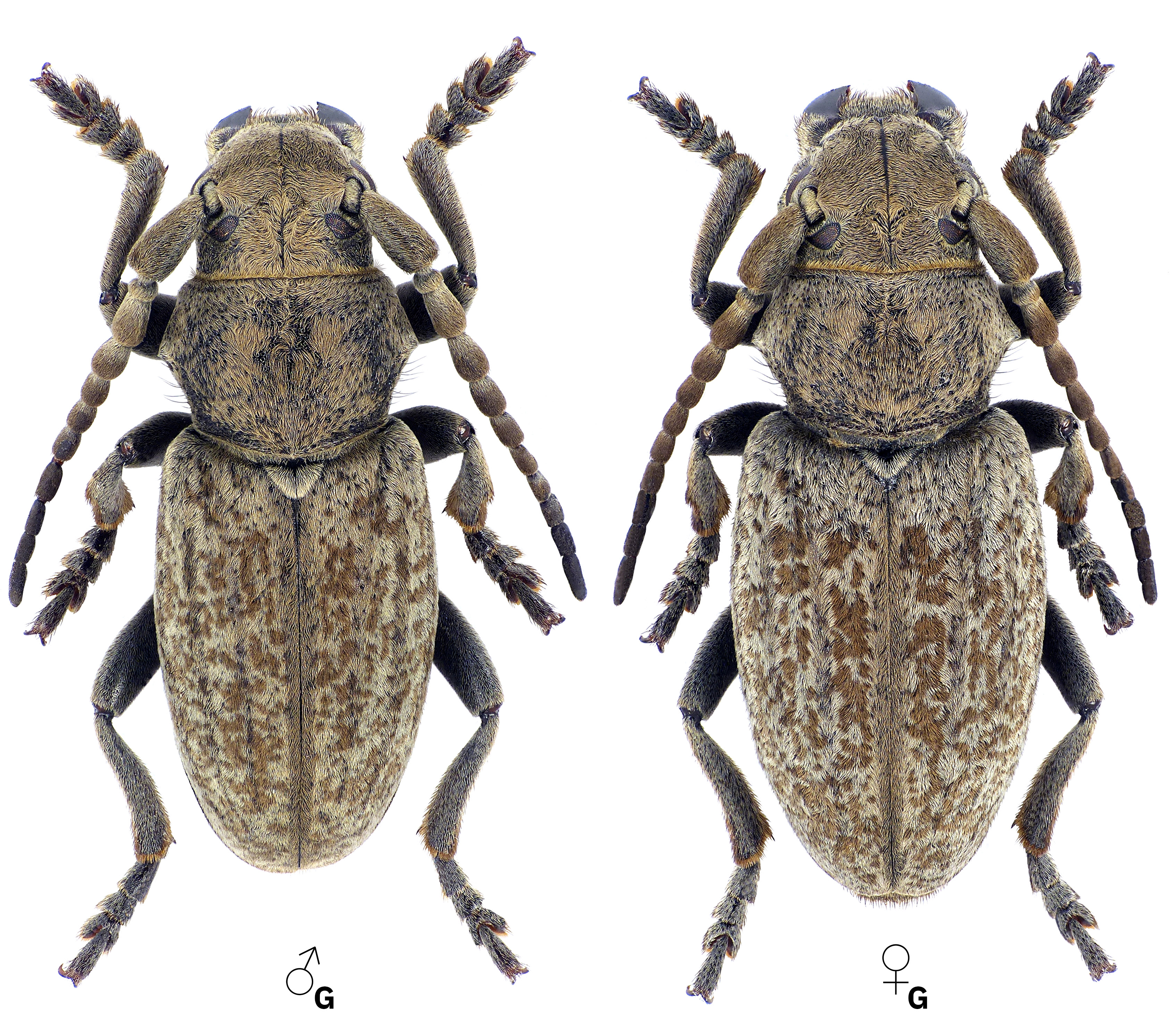[= Iberodorcadion (Baeticodorcadion) grisescens (Escalera, 1900)]
[= Iberodorcadion andalusiacum (Breuning, 1962)]
Subfamilia: LAMIINAE / Tribus: DORCADIONINI

[Photo © Photo © David Navrátil & 8K postprocessing M.Hoskovec, click on the picture for 4K resolution]
Iberodorcadion mus, an endemic species to Andalusia (Southern Spain), has been described from Algeciras (Andalusia) as Dorcadion mus by Wilhelm Gottlob Rosenhauer in 1856 [❖]. The depicted mounted specimens marked with the G-index were for 100 years determined as Iberodorcadion grisescens, which has been described by Manuel Martínez De La Escalera in 1900 [✧]. According to Antonio Verdugo [2001; ▿], however, it is a synonym of I. mus, so the depicted beetles are only an example of the species variability (golden-brown vs. grey tomentum).
I. mus is an univoltine species with a biannual life-cycle. The species overwinters its first winter in larval stage and the second one as a freshly hatched adult, hidden under stones or among the stems of the host grass. Adults begin their activity approximately from September to November, always immediately after the first autumn rains, which soften the ground and allow them to leave their pupal cells. Females lay eggs to the cavity in grass stems, unlike the majority of other Iberodorcadion species, which simply lay eggs among the stems of the host plants [★]. Developmental stages were described by Antonio Verdugo in 1994 [☆].
Body length: 13 - 20 mm Life cycle: 2 years Adults in: from September to November, early spring [?] Host plant: roots and basal stem parts of Poaceae (Phalaris, Polypogon) Distribution: an endemic species to Andalusia (Southern Spain)
The depicted beetles in the upper picture were collected in Alcalá de los Gazules environs (Picacho Camino forestal, La Janda comarca, Province of Cádiz, Andalusia, Spain) on August 21, 2010 (♂) / August 20, 2011 (♀). Specimens depicted in the lower picture (G-index) were reared from larvae found in Ibros environs (La Loma comarca, Province of Jaén, Andalusia, Spain) in May 1995.Collected by J.Navarro and J.Plaza
[❖]
Rosenhauer W.G.:
Die Thiere Andalusiens nach dem Resultate einer Reise zusammengestellt.
Theodor Blaesing, Erlangen, iii-viii + 429pp, 1856. [download]
[✧]
Martínez De La Escalera y Pérez De Rozas M.:
Descripciones de algunas nuevas especies de «Dorcadion».
Actas de la Sociedad Española de Historia Natural 29: 232-241, 1900. [download]
[▿]
Verdugo Páez A.:
Iberodorcadion grisescens (Escalera, 1900), nueva sinonimia de Iberodorcadion mus (Rosenhauer, 1856) (Coleoptera, Cerambycidae, Lamiinae).
Revista de la Sociedad Gaditana de Historia Natural 2: 5-16, 2001.
[download]
[★]
Navarro J., Urbano J.M., Llinares A.:
Iberodorcadion (Baeticodorcadion) mus Rosenhauer, 1856 (Coleoptera, Cerambycidae, Lamiinae, Dorcadiini) en dos localidades de Sevilla (Andalucía, España).
Boletín de la SAE 15:20-29, 2008. [download]
[☆]
Verdugo Páez A.:
Los Iberodorcadion (Breuning, 1943) del suroeste ibérico. Anatomía de las fases biologicas, ciclo vital, ecología y distribución (Coleoptera, Cerambycidae). .
Zapateri: Revista Aragonesa de Entomología 4: 87-103, 1994. [download]
Breuning S.:
Revision der Dorcadionini (Col. Ceramb.)
Abhandlungen und Berichte aus dem staatlichen Museum für Tierkunde in Dresden 27: 666pp [page 543-544], 1962. [download]

[Photo © Photo © David Navrátil & 8K postprocessing M.Hoskovec, click on the picture for 4K resolution]
| Subfamilia | Lamiinae Latreille, 1825 |
| Tribus | Dorcadionini Swainson, 1840 |
| Genus | Iberodorcadion Breuning, 1943 |
| Subgenus | Baeticodorcadion Vives, 1976 |
| Species | Iberodorcadion (Baeticodorcadion) mus (Rosenhauer, 1856) |
